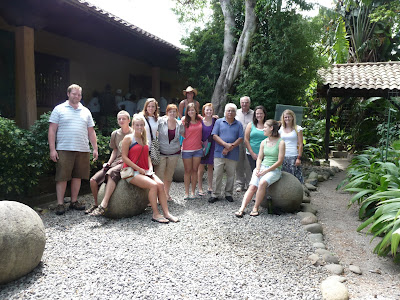
Although San Jose is not one of the worlds greatest metropolises, the National Theater, Museum, as well as some of its parks show that is very much worthy of at least a day's worth of exploring. We headed there as part of our History of Culture class yesterday, and I found the experience enlightening and extremely enjoyable.

As demonstrated by the National Museum, Costa Rica has a rich cultural history. The collection of Indigenous artifacts and artwork show how the lesser known indigenous peoples of Central America were equally as developed as their Mayan, Aztec, and Incan counterparts. Their detailed ceramics and sculpture reveal a complex culture with deep ties to their natural surroundings. The museum is also home to some of the strange spheres that were first found in the Diquis Delta in the 1930's by a banana company. Theories on their origins range from Atlantis to aliens, though they are probably just another example of incredible ingenuity on the part of Native Americans. In addition to the rich indigenous culture, the museum presented the entirety of Costa Rican

history from the colonial period onward. Through the brief captions, maps, and bountiful items of historical importance we furthered our understanding of how Costa Rica has come to be what it is today.
Our next stop consisted of the Paque Nacional, which is home to Costa Rica's most important monument. The sculpture in the center of the park depicts the 5 nations of Central America pushing forward as the notorious William Walker cowers away in defeat. Men like William Walker were known as "filibusters" or "freebooters." Filibusters were Americans who engaged in unauthorized military expeditiosn in a foreign nation for financial gain, adventure, or a belief in manifest destiny. Walker attempted to conquer Central America after successfully conquering Nicaragua. He was defeated by Costa Rica

in a series of battles in 1856; hence, in the sculpture you see Costa Rica holding her sword forth ward as she aids Nicaragua who is being carried under her arm.
We then made our way into the old National Factory of Liquors which currently houses a dance school as well as some art displays. We checked out a contemporary art display dealing with immigration within and outside of Latin America and how it has become a part of life. Unfortunately there were no photos allowed, so I will spare you any lengthy descriptions of the pieces on display.

We then strolled through Parque
España and Morazán before making our way to El Teatro Nacional. The theater was constructed in 1897 and pays homage to Costa Rica's European roots by embracing the Neoclassical architecture of the Renaissance. Sculptures found atop and within the theater are reminiscent of those of Hellenistic Greece and ancient Rome. The most Costa Rican aspect of the theater was the multicolored wood floor of the foyer which is made from the countless types of tropical hardwood found in the many different types of forest here. The theater is an important piece of cultural heritage for Costa Ricans. It was bought and paid for by coffee farmers working together with the government, so that they may have a cultural center for the many traveling operas, orchestras, symphonies, and theater troupes of Europe, the U.S., and their fellow Latin Americans.
Finally, we finished our day with lunch at the Grand Hotel of Costa Rica located across from the theater. San Jose proved to have a lot to offer travelers today. As long as you are willing to learn a little history and do a little walking San Jose is great one day stop for any Costa Rica vacation.




 great beaches. For the most part this weekend we focused on relaxation and spent most of our time enjoying the sun and the water right out in front of our beautiful hotel. The hotel we stayed at was the nicest one we have been to so far, and was a great place to simply relax. Saturday we were able to go snorkeling and on Sunday we took a ride on a banana boat around the gulf. The hotel had 20 dollar per hour massages right on the beach. Moreover, every day before sunset a family of Howler Monkeys would descend upon our hotel. The receptionists let me
great beaches. For the most part this weekend we focused on relaxation and spent most of our time enjoying the sun and the water right out in front of our beautiful hotel. The hotel we stayed at was the nicest one we have been to so far, and was a great place to simply relax. Saturday we were able to go snorkeling and on Sunday we took a ride on a banana boat around the gulf. The hotel had 20 dollar per hour massages right on the beach. Moreover, every day before sunset a family of Howler Monkeys would descend upon our hotel. The receptionists let me  go up to the third floor which was under construction, so that I may be right in the level of the tree tops to take photos. I'm not much of one to advertise for places we visit, but I definitely hope to return to Hotel Playa Hermosa Bosque del Mar (despite the convoluted name). Mostly because of the swan-shaped towels but also because of its great location in a none to commercialized town on a great beach that offers a lot of little adventures.
go up to the third floor which was under construction, so that I may be right in the level of the tree tops to take photos. I'm not much of one to advertise for places we visit, but I definitely hope to return to Hotel Playa Hermosa Bosque del Mar (despite the convoluted name). Mostly because of the swan-shaped towels but also because of its great location in a none to commercialized town on a great beach that offers a lot of little adventures.






































